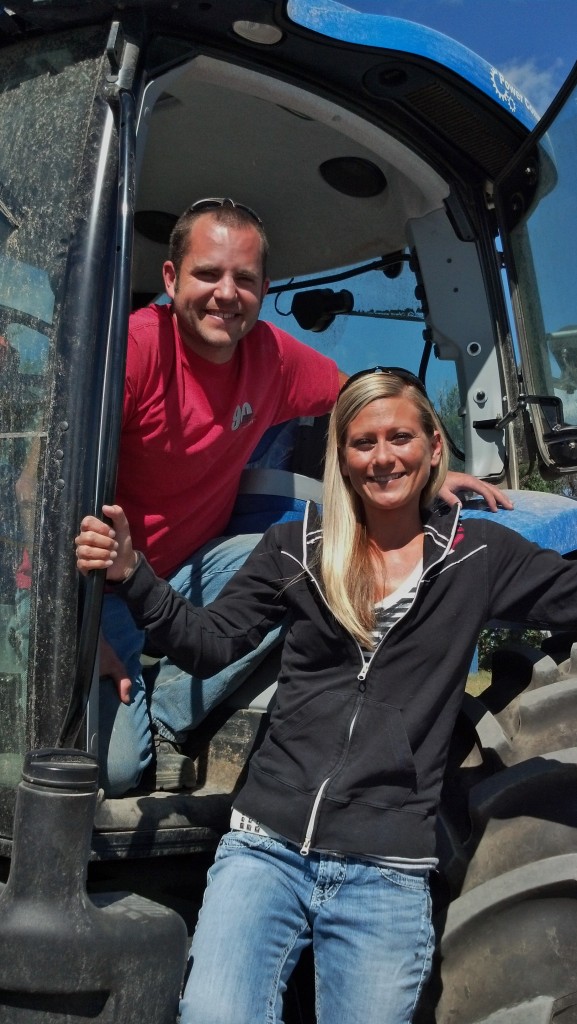Researchers Look to Pig Vaccines to Prevent Costly Diseases
Grant Money + Mushrooms = Profit for Farmers
A grant by the U.S. Department of Agriculture has farmers in the Northeast growing a lot more mushrooms. The $116,000 grant provided to the University of Vermont and Cornell University found that growing shiitake mushrooms outdoors on logs can be profitable. At almost $16 a pound, the mushrooms can bring in about $11,190 in gross income. The good news? Demand for the shrooms is outweighing supply. Read more (Associated Press).
FSA Keeps Third Generation in the Dairy Business

Eric and Allison are third generation farmers who used an FSA Operating Loan to take the business to the next level.
By Sarah Kern, Minnesota Farm Service Agency
When Eric Johnson finished high school, he didn’t see cows in his future.
“I wanted a new adventure and I wanted to try something different after being on the farm my whole life,” said Eric. “I tried carpentry and later worked at a nursery as a landscaper laying paver patios and building rock walls.”
Landscaping didn’t employ year-round so he began work at a large dairy. This is also how he met his wife Alison. “I enjoyed my work on the dairy farm and that’s when I realized I missed working on the farm where I grew up,” said Eric.
Several years later, his dad, Harold, needed a new herd manager and offered Eric the job. He jumped at the chance.
Since coming back to the farm, Eric and Alison, have taken over the farm and continue as third generation owners and operators of the Johnson Family Farm that has been milking cows in southern Meeker County, Minnesota, since 1925. Continue reading
Some Nuts May Have Less Calories Than Originally Thought
There’s more good news about almonds and pistachios. Using an improved method for estimating calories, USDA researchers found that there are fewer calories in the nuts than previously thought. The new method, which is expected to work well with other foods, takes into consideration the fat in some hard foods that is not completely absorbed because it is difficult to digest the food’s cell walls. By measuring calories intake and foods’ excreted remains, scientists said the caloric value of pistachios has likely been overestimated by 5 percent. Read more.
Americans Not Drinking Milk as Often as Their Parents
Milk consumption in the U.S. is changing. A report from the USDA Economic Research Service states Americans of all ages are drinking less milk. Differences between generations along with eating and drinking habits contribute to the trend. According to the report, Americans born in the 1970s drank less milk in their teens, twenties and thirties than Americans born in the 1960s. Those born in the 1980s and 1990s appear to drink even less milk in their adulthood than those born in the 1970s. Wider beverage selection and the food environment in which one comes of age are factors in milk drinking variations. Review the study.
Latest Crop Report Puts Corn at Record-Breaking Pace
Corn may be headed for a record-breaking year based on this month’s USDA Crop Report. The report, released on Thursday, forecasts corn at 13.8 billion bushels, up less than1 percent from last month and 28 percent from 2012. If reached, corn production will be the highest on record for the United States. Yields are expected to average 155.3 bushels per acre, just slightly higher than last month’s forecast and 31.9 bushels above the 2012 average. Soybeans are set to produce 3.15 billion bushels, down 3 percent from August, but up 4 percent from last year. If met, this would be the fourth largest soybean production on record. Read the crop report.
Study Shows USDA Program Does Work to Benefit the Land
The U.S. Department of Agriculture’s Farm and Ranch Lands Protection Program (FRPP) is doing what it was designed to do — improve agricultural viability, encourage on-farm conservation and help farmers gain access to land — according to a study by the American Farmland Trust. FRPP supports agricultural viability by providing liquid capital to farmers to invest in their operations. The program also requires conservation plans be put in place for highly erodible land and certain forested parcels for on-farm conservation, and it helps finance land acquisitions and makes land more affordable for beginning farmers and those looking to expand. Review the study.
Community Gets Buzzed Over Honeybee Tour

Joaquin Llerenas shows visitors how bees make honey and attempts to locate the queen during one of Llerenas Apiaries bee farm tours.
It doesn’t take much to get up close and personal with thousands of honeybees in North Dakota. Just sign up to take a tour — a bee tour.
Hundreds of people are lining up to take a walk through Llerenas Apiaries bee farm to learn how bees operate, communicate and work together to make that sweet, sticky nectar.
“Most people see bees outside and on the roadside and they don’t think much about them,” said Joaquin Llerenas. “We do the tours to show people what bees are really like.” Continue reading
From Medicine to Agriculture: One Intern’s Six-Month Adventure at USDA

Veteran LeRoy Robinson worked an outreach event during his six-month internship at USDA that allowed him to work at headquarters in Washington, D.C. and in a state office in Richmond, Va.
By LeRoy Robinson
How does a guy with a medical background end up working in agriculture?
That was the question I asked myself after beginning a non-paid internship with USDA. The internship started in January after speaking with my rehabilitation counselor at the Department of Veterans Affairs. After working as a radiologic technologist for the Air Force, this was a 180 degree change. For some reason a personnel security position within the Farm Service Agency (FSA) stood out. I thought it would be interesting so I connected with FSA’s veteran program coordinator in Washington D.C. and set up an interview. Continue reading
Most Farm Households Rely on Off-Farm Income
Most farm households earn all of their income from nonfarm sources, according to a USDA report released this month. Based on the broad definition of a farm, which includes several small operations that produce little or no agricultural commodities in a given year, many farm households rely solely on income made off the farm. Even those operating farms with substantial production have significant nonfarm income. The report stated that 91 percent of farm households have at least one family member working at an off-farm job. Of that number, 35.9 percent held professional and management positions. Learn more.





